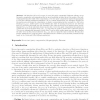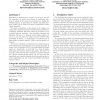2414 search results - page 123 / 483 » Computing Normal Subgroups |
STOC
2005
ACM
14 years 9 months ago
2005
ACM
We introduce the novel concept of covert two-party computation. Whereas ordinary secure two-party computation only guarantees that no more knowledge is leaked about the inputs of t...
PODC
2006
ACM
14 years 3 months ago
2006
ACM
Motivated by applications to sensor, peer-to-peer, and adhoc networks, we study the problem of computing functions of values at the nodes in a network in a totally distributed man...
IPPS
1999
IEEE
14 years 1 months ago
1999
IEEE
Using off-the-shelf commodity workstations and PCs to build a cluster for parallel computing has become a common practice. A choice of a cost-effective cluster computing platform ...
POPL
2009
ACM
14 years 3 months ago
2009
ACM
With the emergence of commodity multicore architectures, exploiting tightly-coupled parallelism has become increasingly important. Functional programming languages, such as Haskel...
TCC
2004
Springer
14 years 2 months ago
2004
Springer
Quantum 2-party cryptography differs from its classical counterpart in at least one important way: Given blak-box access to a perfect commitment scheme there exists a secure 1−2...


